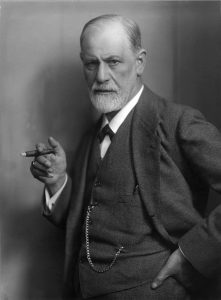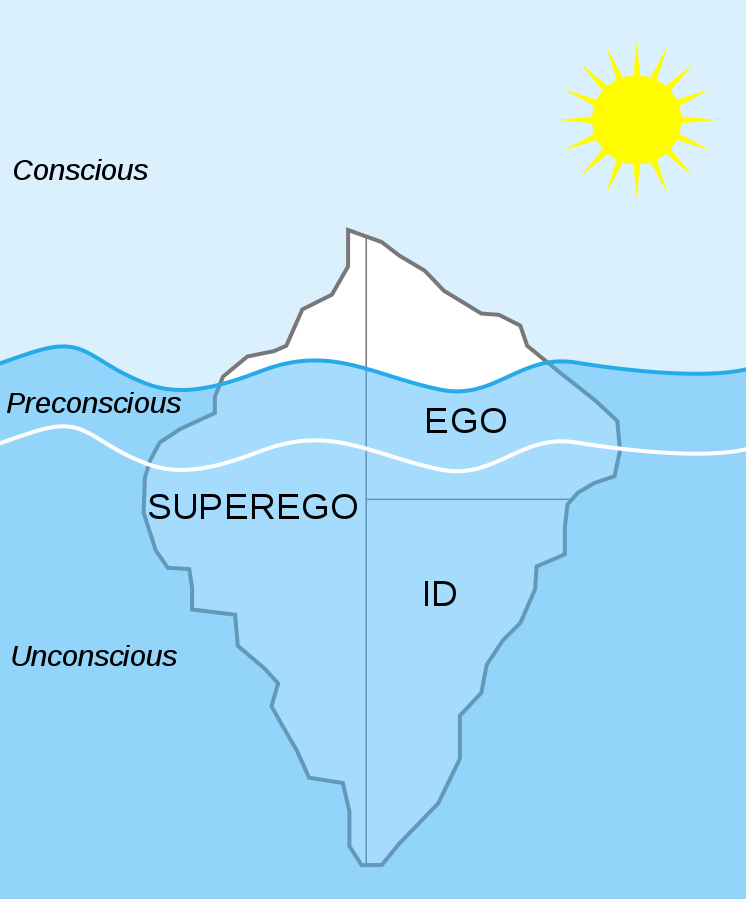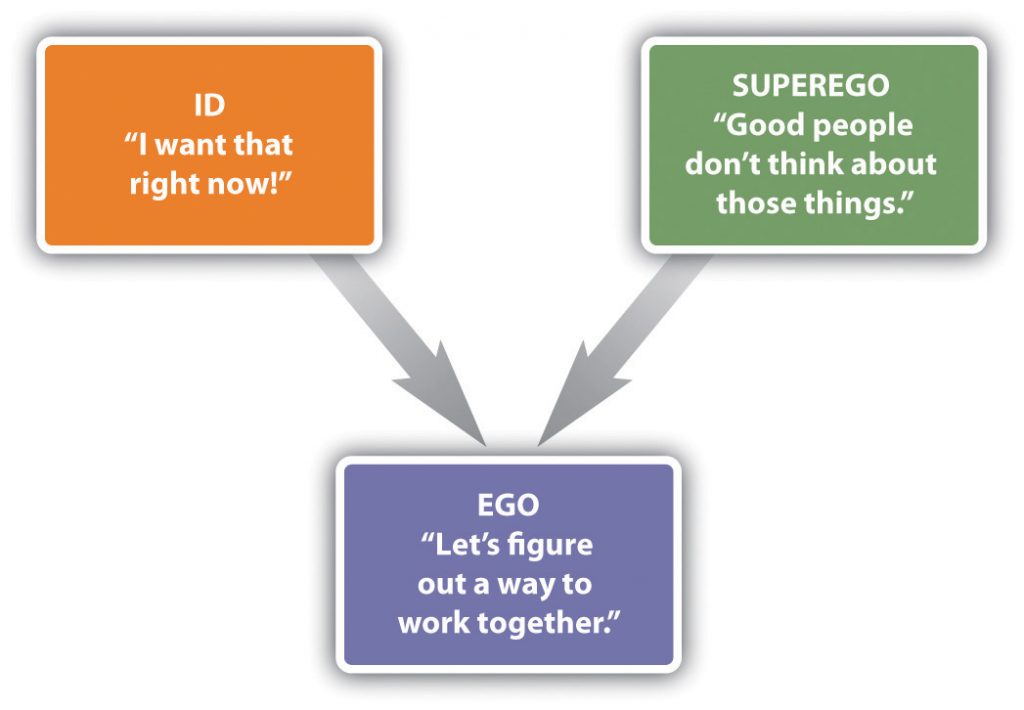1930s: Freud
Saylor Academy and Diana Lang
Freud and Psychodynamic Theories of Personality: The Role of the Unconscious

One of the most important psychological approaches to understanding personality is based on the theorizing of the Austrian physician and psychologist Sigmund Freud (1856–1939), who founded what is known today as the psychodynamic approach to understanding personality.[1] Many people know about Freud because his work has had a long-standing impact on our everyday thinking about psychology, and the psychodynamic approach is one of the most important approaches to psychological therapy.[2] [3] Freud is probably the best known psychologist, in part because of his impressive observation and analyses of personality (there are 24 volumes of his writings). As is true of all theories, many of Freud’s ingenious ideas have turned out to be at least partially incorrect, but yet other aspects of his theories are still influencing psychology.
Freud used the observations that he and French neurologist Jean-Martin Charcot (1825–1893) made to develop his theory regarding the sources of personality and behavior, and his insights are central to the fundamental themes of psychology. In terms of free will, Freud did not believe that we are able to control our own behaviors. Rather, he believed that all behaviors are predetermined by motivations that lie outside our awareness, in the unconscious. These forces show themselves in our dreams, in neurotic symptoms such as obsessions, while we are under hypnosis, and in Freudian “slips of the tongue” in which people reveal their unconscious desires in language. Freud argued that we rarely understand why we do what we do, although we can make up explanations for our behaviors after the fact. For Freud the mind was like an iceberg – many motivations of the unconscious being much larger, but out of sight, in comparison to the consciousness of which we are aware.

Id, Ego, and Superego
Freud proposed that the mind is divided into three components: the id, ego, and superego, and that the interactions and conflicts among the components create a personality.[4] According to Freudian theory, the id is the component of personality that forms the basis of our most primitive impulses. The id is entirely unconscious, and it drives our most important motivations, including the sexual drive (libido) and the aggressive or destructive drive (Thanatos). According to Freud, the id is driven by the pleasure principle—the desire for immediate gratification of our sexual and aggressive urges. The id is why we smoke cigarettes, drink alcohol, view pornography, tell mean jokes about people, and engage in other fun or harmful behaviors, often at the cost of doing more productive activities.
The function of the ego is based on the reality principle—the idea that we must delay gratification of our basic motivations until the appropriate time with the appropriate outlet. The ego is the largely conscious controller or decision-maker of personality. The ego serves as the intermediary between the desires of the id and the constraints of society contained in the superego (Figure 2. “Ego, Id, and Superego in Interaction”). We may wish to scream, yell, or hit, and yet our ego normally tells us to wait, reflect, and choose a more appropriate response.
In stark contrast to the id, the superego represents our sense of morality and doing what is “right”. The superego tells us all the things that we shouldn’t do, or the duties and obligations of society. The superego strives for perfection, and when we fail to live up to its demands we feel guilty.

Freud believed that psychological disorders, particularly the experience of anxiety, occur when there is conflict or imbalance among the motivations of the id, ego, and superego. When the ego finds that the id is pressing too hard for immediate pleasure, it attempts to correct or compensate for this problem, often through the use of defense mechanisms—unconscious psychological strategies used to cope with anxiety and to maintain a positive self-image. Freud believed that defense mechanisms were essential for effective coping with everyday life, but that any of them could be overused (See Table 1. “The Major Freudian Defense Mechanisms”).
| Defense mechanism | Definition | Possible behavioral example |
|---|---|---|
| Displacement | Diverting threatening impulses away from the source of the anxiety and toward a more acceptable source | A student who is angry at her professor for a low grade lashes out at her roommate, who is a safer target of her anger. |
| Projection | Disguising threatening impulses by attributing them to others | A man with powerful unconscious sexual desires for women claims that women use him as a sex object. |
| Rationalization | Generating self-justifying explanations for our negative behaviors | A drama student convinces herself that getting the part in the play wasn’t that important after all. |
| Reaction formation | Making unacceptable motivations appear as their exact opposite | Jane is sexually attracted to friend Jake, but she claims in public that she intensely dislikes him. |
| Regression | Retreating to an earlier, more childlike, and safer stage of development | A college student who is worried about an important test begins to suck on his finger. |
| Repression (or denial) | Pushing anxiety-arousing thoughts into the unconscious | A person who witnesses his parents having sex is later unable to remember anything about the event. |
| Sublimation | Channeling unacceptable sexual or aggressive desires into acceptable activities | A person participates in sports to sublimate aggressive drives. A person creates music or art to sublimate sexual drives. |
The most controversial, and least scientifically valid, part of Freudian theory is its explanations of personality development. Freud argued that personality is developed through a series of psychosexual stages, each focusing on pleasure from a different part of the body (See Table 2. “Freud’s Stages of Psychosexual Development”). Freud believed that sexuality begins in infancy and that the appropriate resolution of each stage has implications for later personality development.
| Stage | Approximate ages | Description |
|---|---|---|
| Oral | Birth to 18 months | Pleasure comes from the mouth in the form of sucking, biting, and chewing. |
| Anal | 18 months to 3 years | Pleasure comes from bowel and bladder elimination and the constraints of toilet training. |
| Phallic | 3 years to 6 years | Pleasure comes from the genitals, and the conflict is with sexual desires for the opposite-sex parent. |
| Latency | 6 years to puberty | Sexual feelings are less important. |
| Genital | Puberty and older | If prior stages have been properly reached, mature sexual orientation develops. |

In the first of Freud’s proposed stages of psychosexual development, which begins at birth and lasts until about 18 months of age, the focus is on the mouth. During this oral stage, the infant obtains sexual pleasure by sucking and drinking. Infants who receive either too little or too much gratification become fixated or “locked” in the oral stage, and are likely to regress to these points of fixation under stress, even as adults.
According to Freud, a child who receives too little oral gratification (e.g., who was underfed or neglected) will become orally dependent as an adult and be likely to manipulate others to fulfill his or her needs rather than becoming independent. On the other hand, the child who was overfed or overly gratified will resist growing up and try to return to the prior state of dependency by acting helpless, demanding satisfaction from others, and acting in a needy way.
The anal stage, lasting from about 18 months to 3 years of age is when children first experience psychological conflict. During this stage, children desire to experience pleasure through bowel movements, but they are also being toilet trained to delay this gratification. Freud believed that if this toilet training was either too harsh or too lenient, children would become fixated in the anal stage and become likely to regress to this stage under stress as adults. If the child received too little anal gratification (i.e., if the parents had been very harsh about toilet training), the adult personality would be anal retentive—stingy, and compulsively seeking order and tidiness. On the other hand, if the parents had been too lenient, the anal expulsive personality would be the result, characterized by a lack of self-control and a tendency toward messiness and carelessness.
The phallic stage, which lasts from age 3 to age 6, is when the penis (for boys) and clitoris (for girls) become the primary erogenous zone for sexual pleasure. During this stage, Freud believed that children develop a powerful but unconscious attraction for the opposite-sex parent, as well as a desire to eliminate the same-sex parent as a rival. Freud based his theory of sexual development in boys (the “Oedipus complex”) on the Greek mythological character Oedipus, who unknowingly killed his father and married his mother, and then gouged his own eyes out when he learned what he had done. Freud argued that boys will normally eventually abandon their love of the mother, and instead identify with the father, also taking on the father’s personality characteristics, but that boys who do not successfully resolve the Oedipus complex will experience psychological problems later in life. Although it was not as important in Freud’s theorizing, in girls the phallic stage is often termed the “Electra complex,” after the Greek character who avenged her father’s murder by killing her mother. Freud believed that girls frequently experienced penis envy, the sense of deprivation supposedly experienced by girls because they do not have a penis. Scholars have heavily criticized this concept in the decades since Freud’s work and it is no longer taken seriously in the psychological community.[5]
The latency stage is a period of relative calm that lasts from about 6 years to 12 years of age. During this time, Freud believed that sexual impulses were repressed, leading boys and girls to have little or no interest in members of the opposite sex.
The fifth and last stage, the genital stage, begins about 12 years of age and lasts into adulthood. According to Freud, sexual impulses return during this time frame, and if development has proceeded normally to this point, the child is able to move into the development of mature romantic relationships. But if earlier problems have not been appropriately resolved, difficulties with establishing intimate love attachments are likely.
Key Takeaways
- Stages of sexual and emotional development: oral, anal, phallic, latency, and genital.
- Human personality contains the id, ego, and superego.
- Individuals have unconscious drives and should be allowed to follow their own instincts.
- A more relaxed approach to child-rearing for improved well-being.
- This chapter is an adaptation of The Origins of Personality by Saylor Academy and [Author removed at request of publisher] and is used under a CC BY NC SA license. ↵
- Roudinesco, E. (2003). Why psychoanalysis? New York, NY: Columbia University Press. ↵
- Taylor, E. (2009). The mystery of personality: A history of psychodynamic theories. Springer Science. ↵
- Freud, S. (1949). The ego and the id. Hogarth Press. (Original work published 1923). ↵
- Thompson, C. (1943). "Penis envy" in women. Psychiatry, 6(2): 123. ↵
The intermediary (reality) aspect of the self, which is situated between the desires of the id and the morality of the superego.
The unconscious (conscience) aspect of the self that handles morality, regulation of desires, and obligations to society.
Unconscious, psychological strategies used to cope with anxiety and to maintain a positive self-image.

